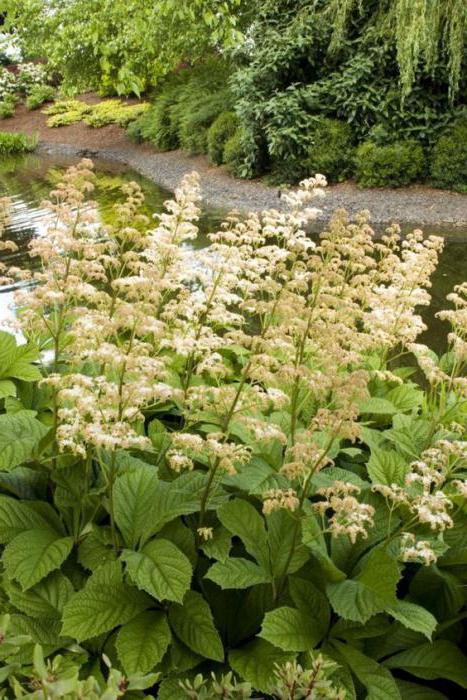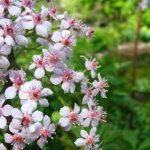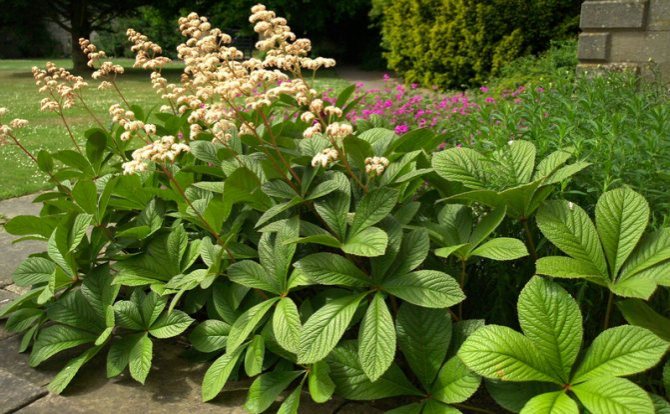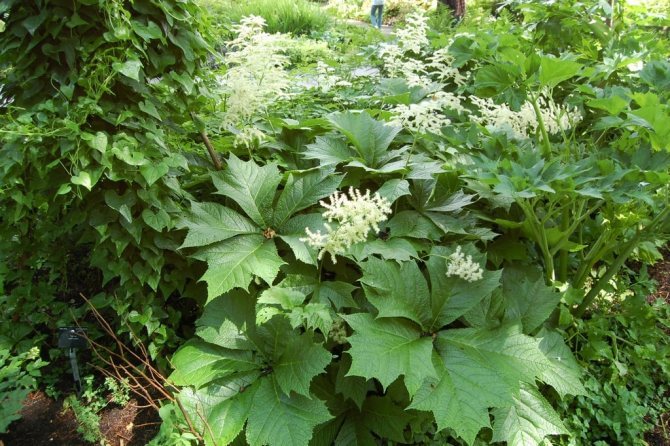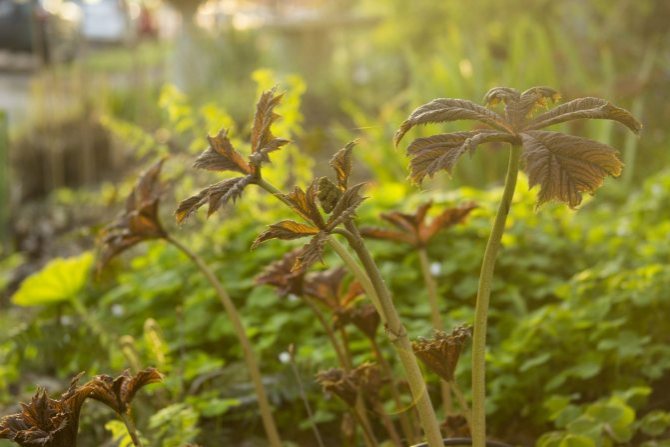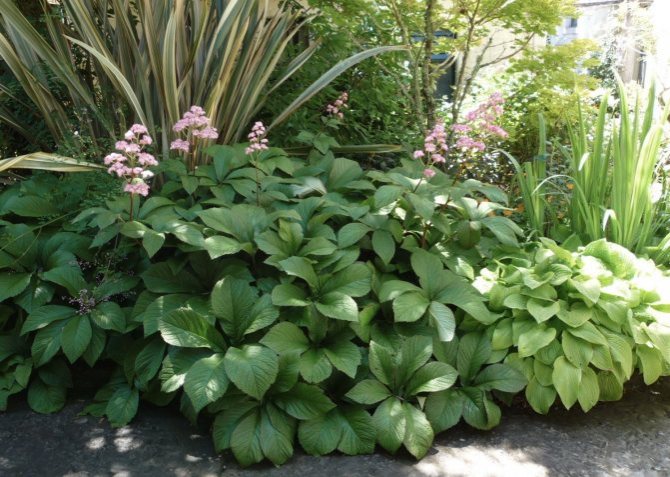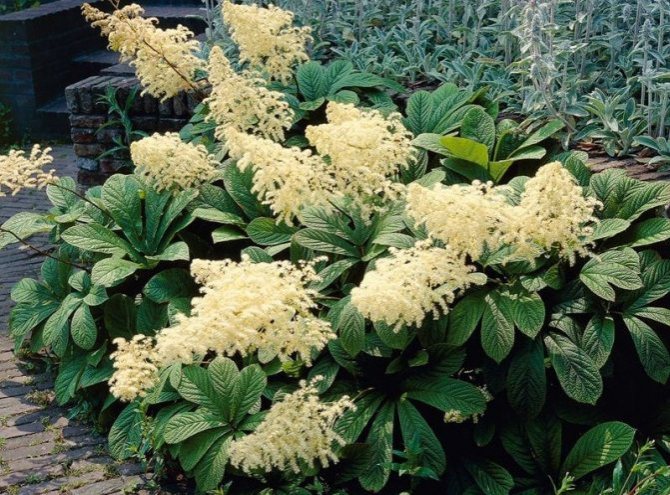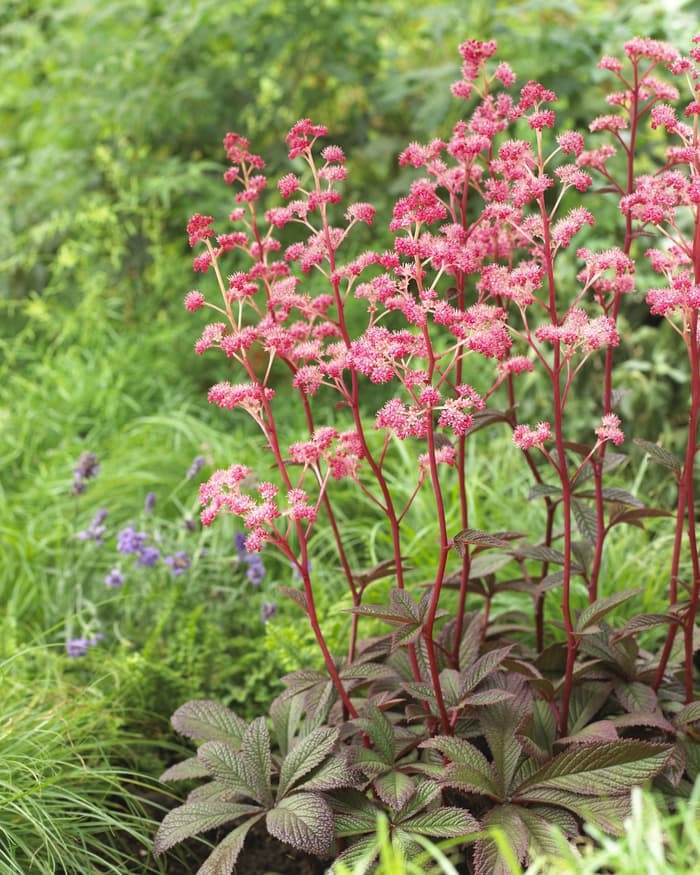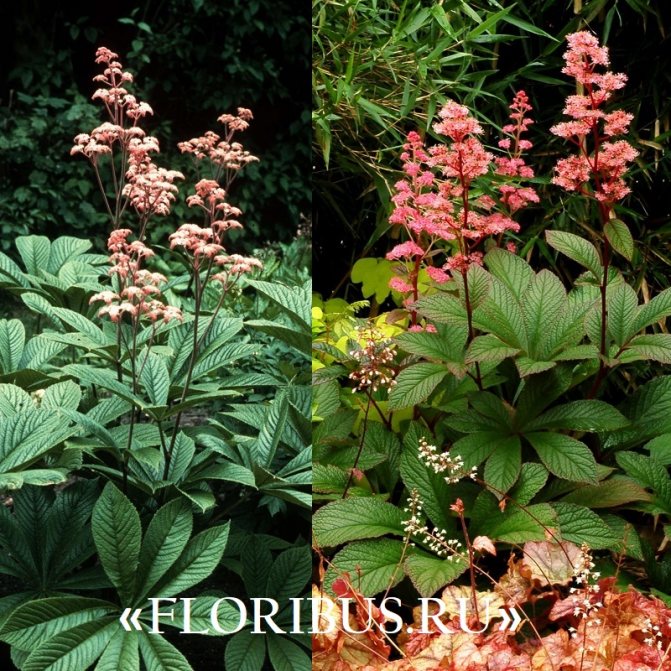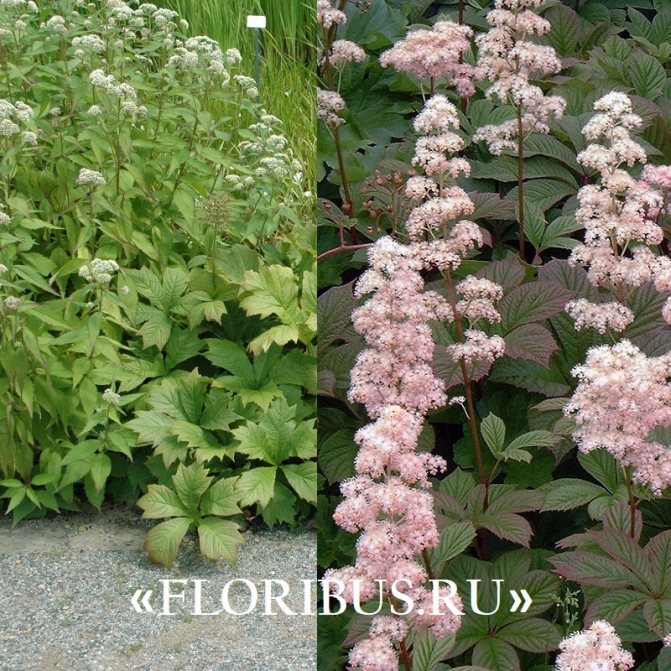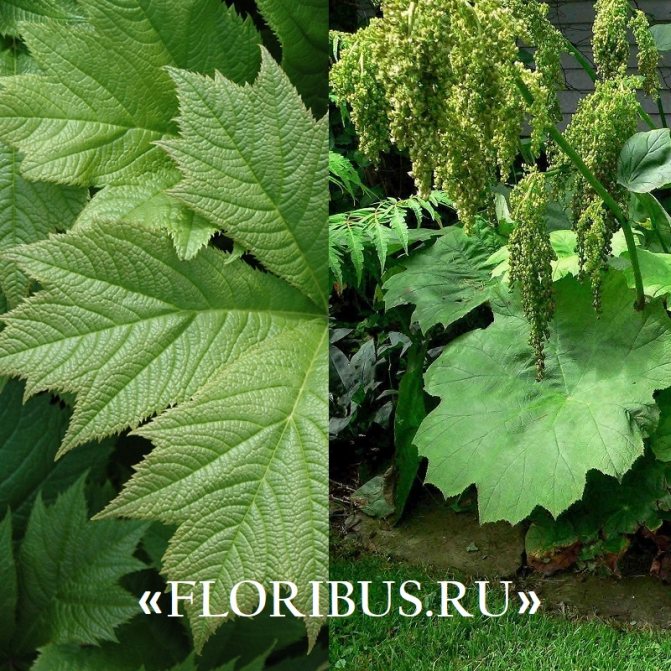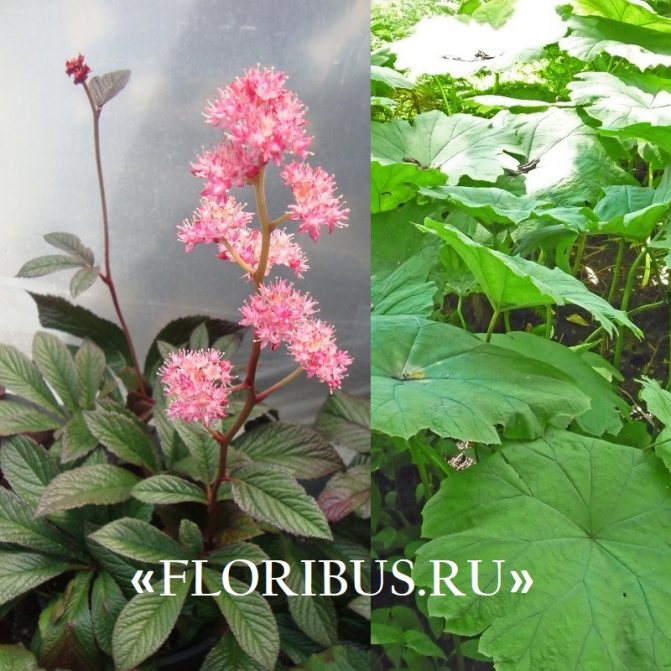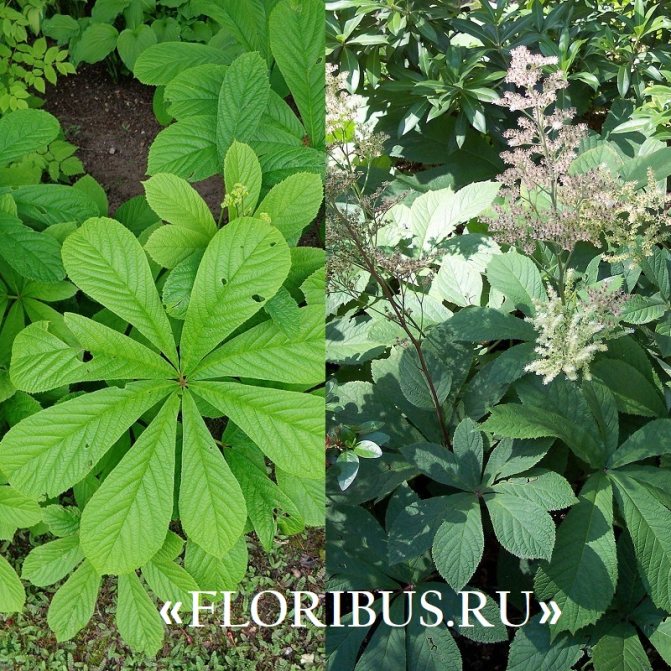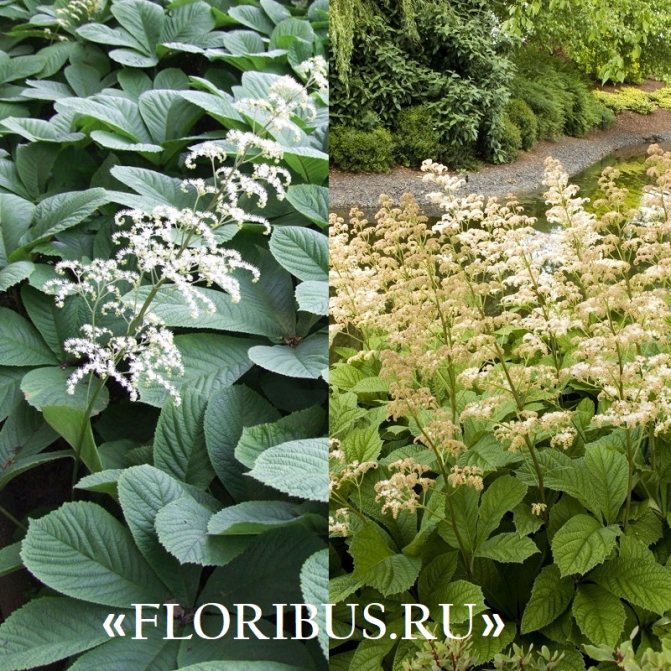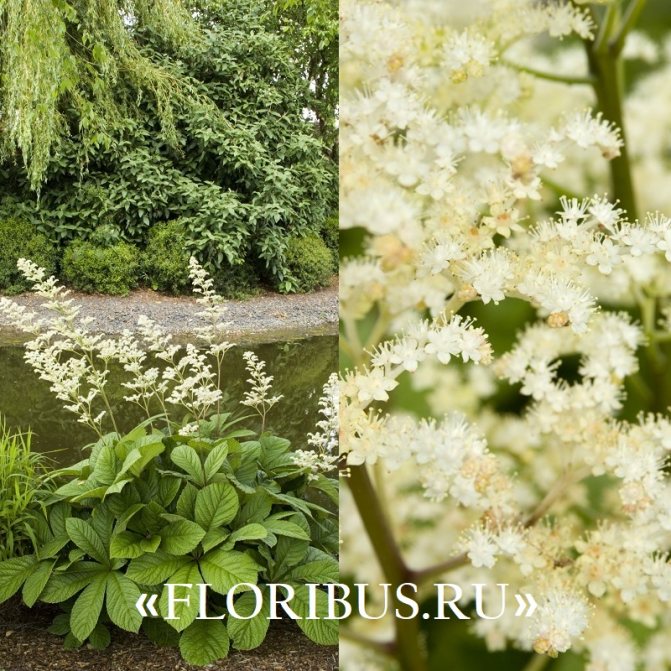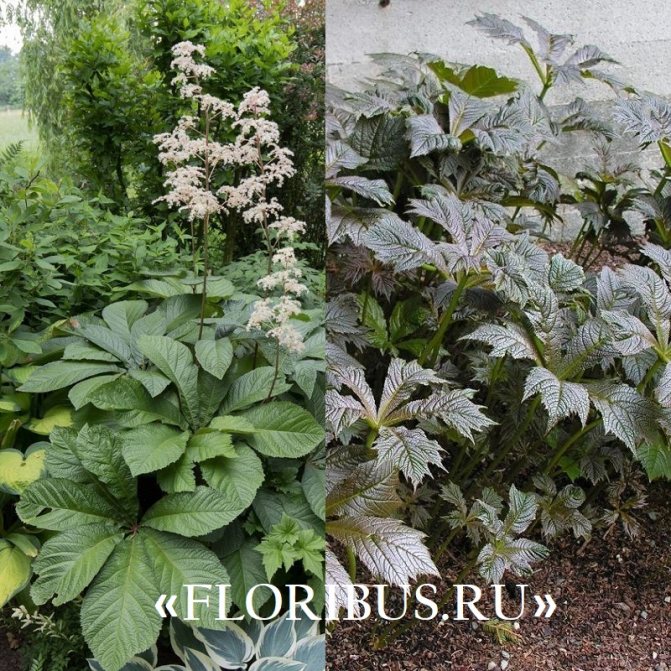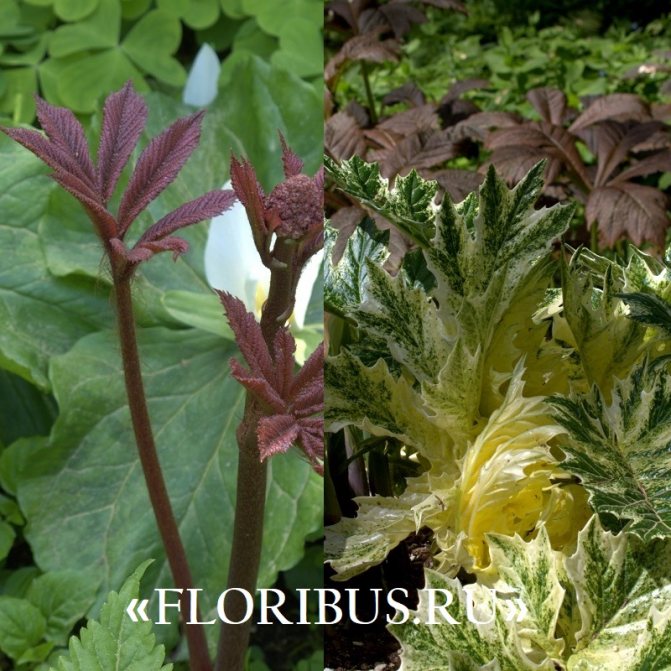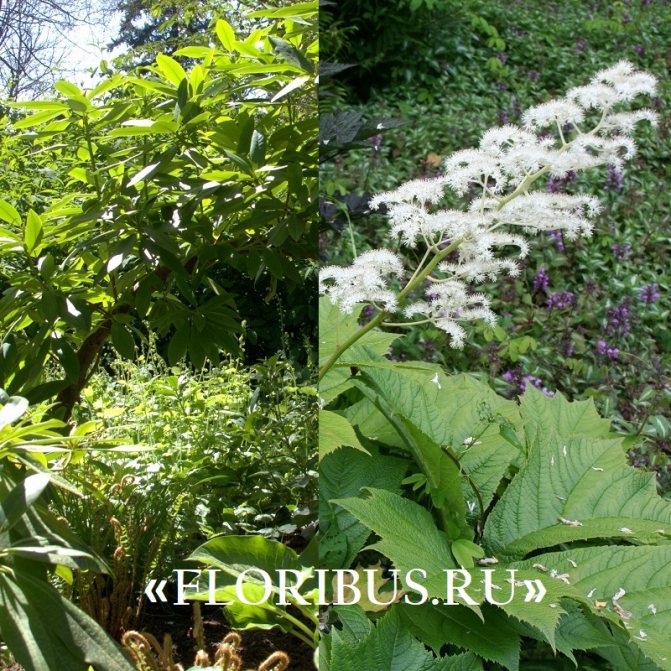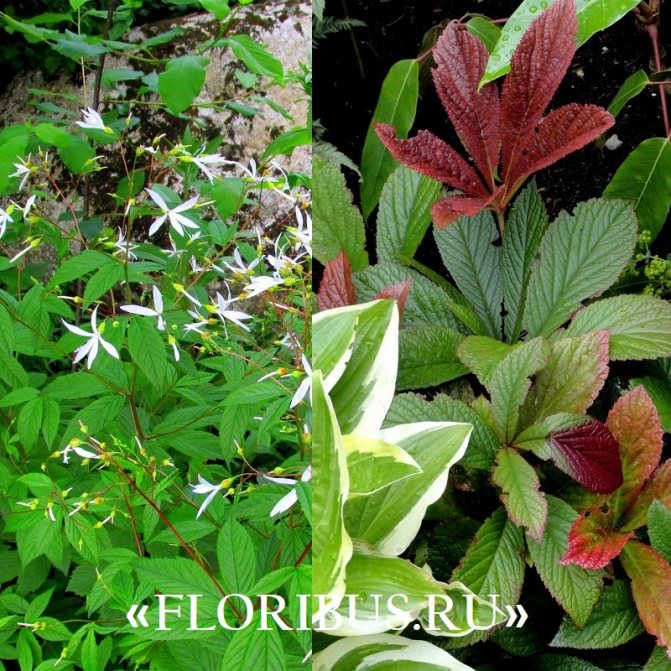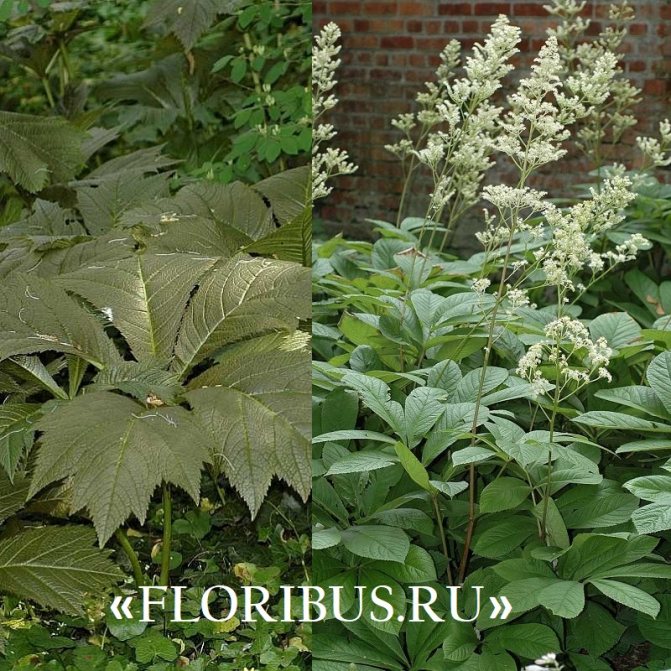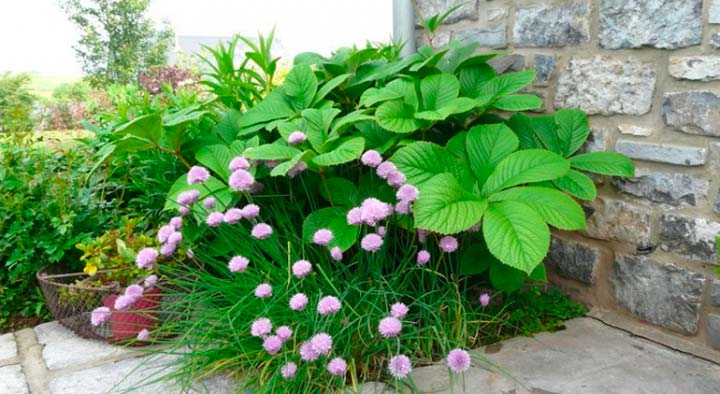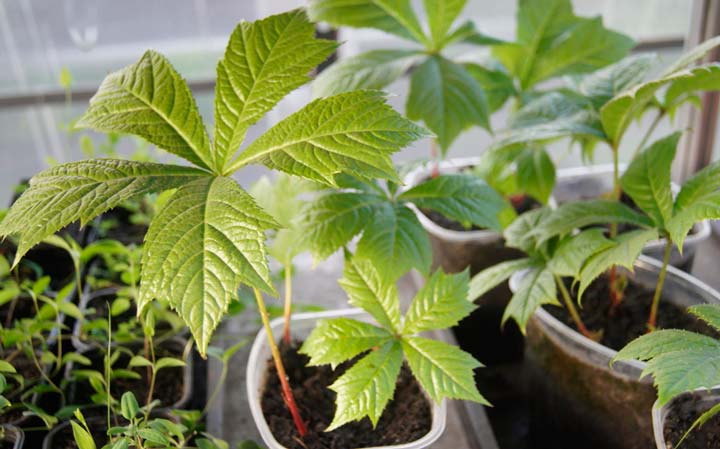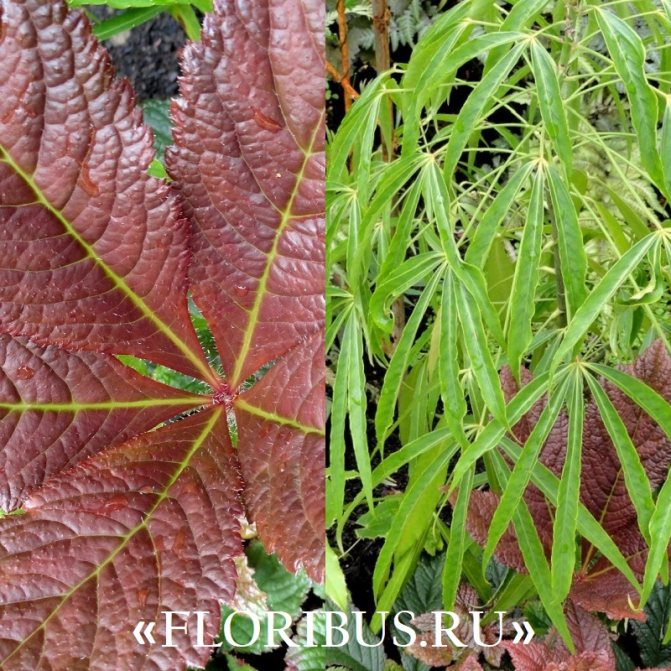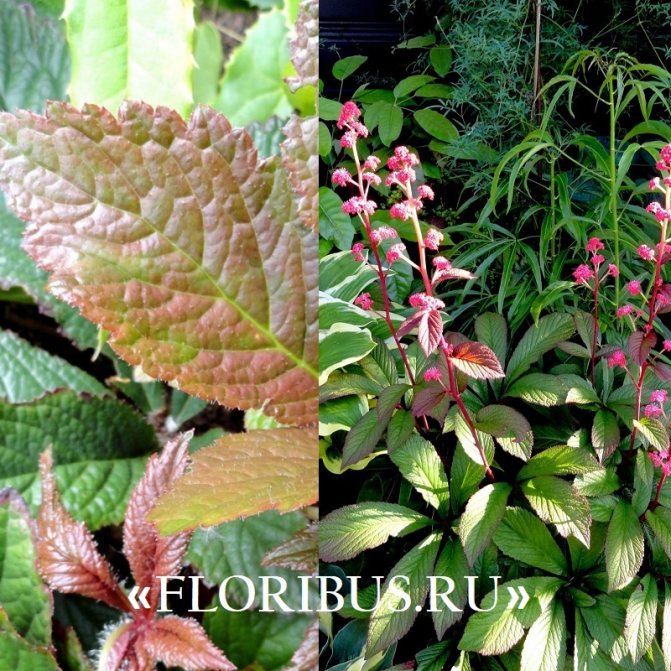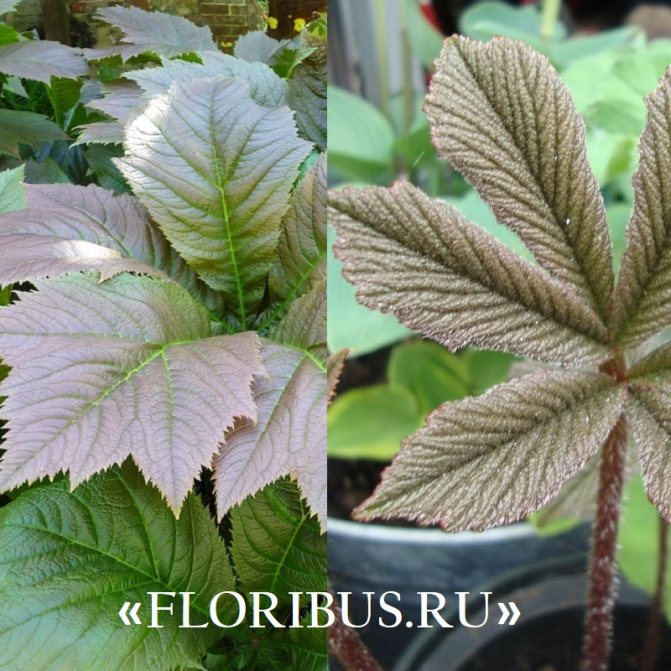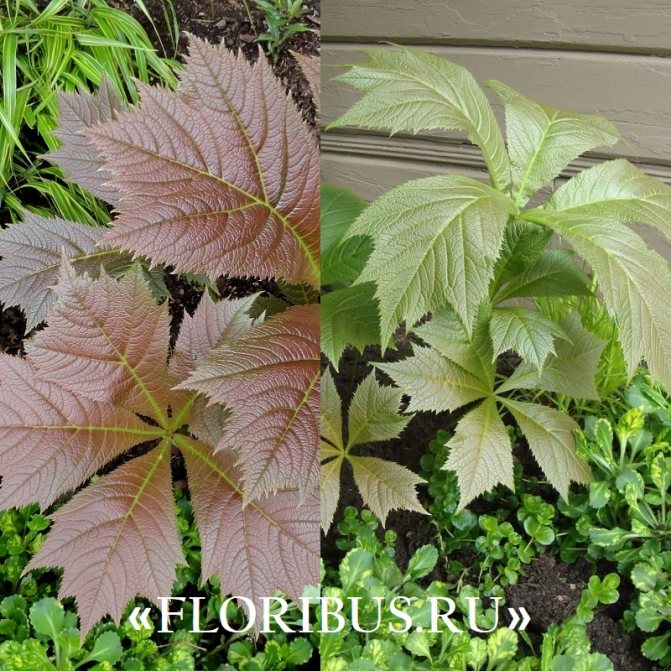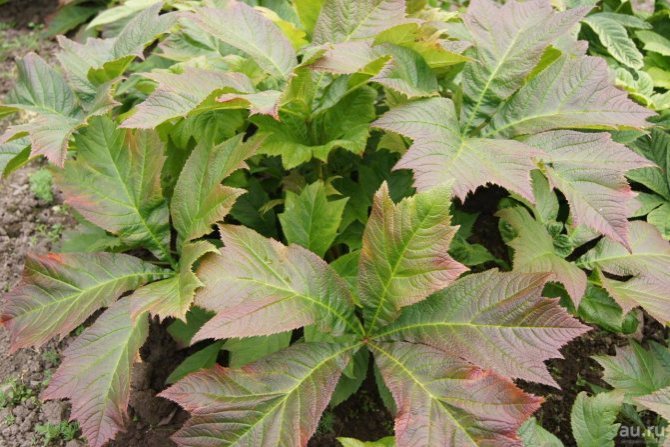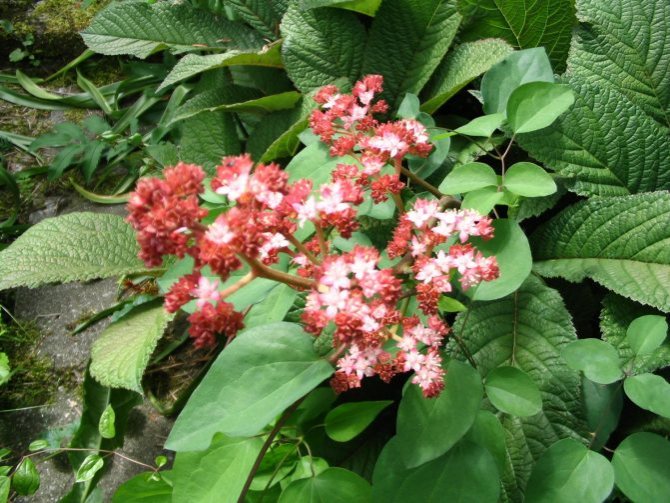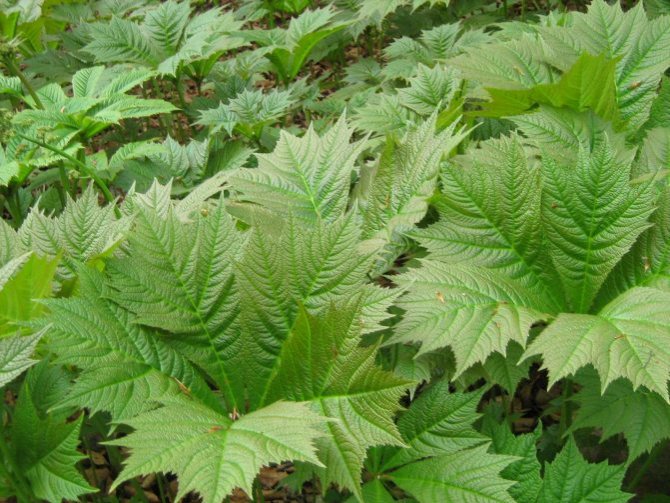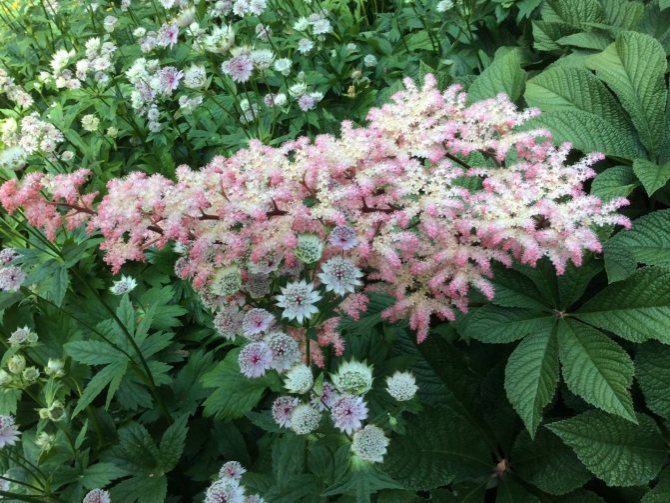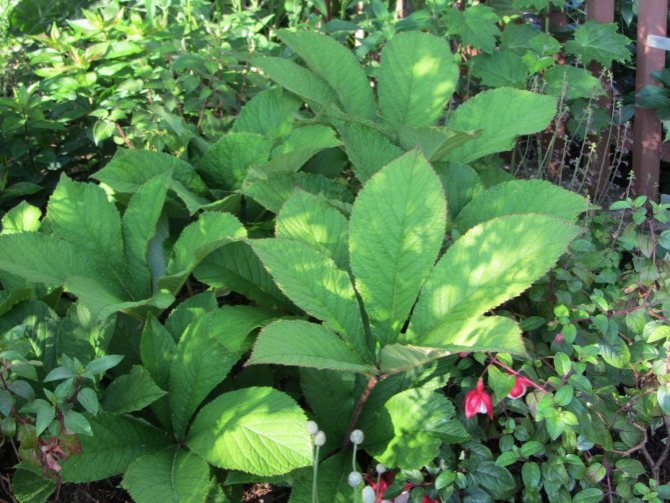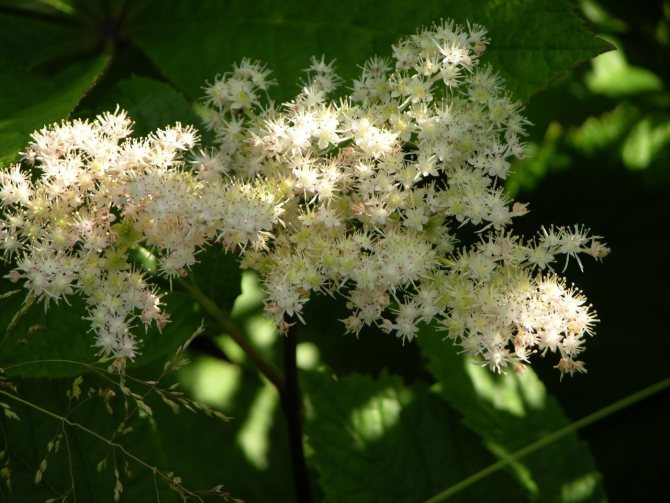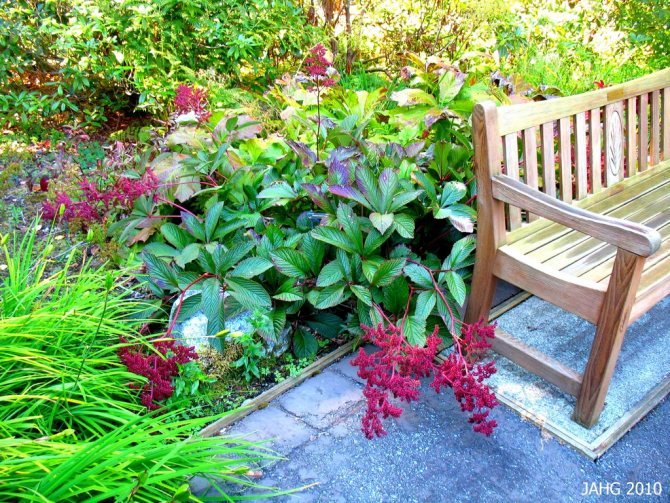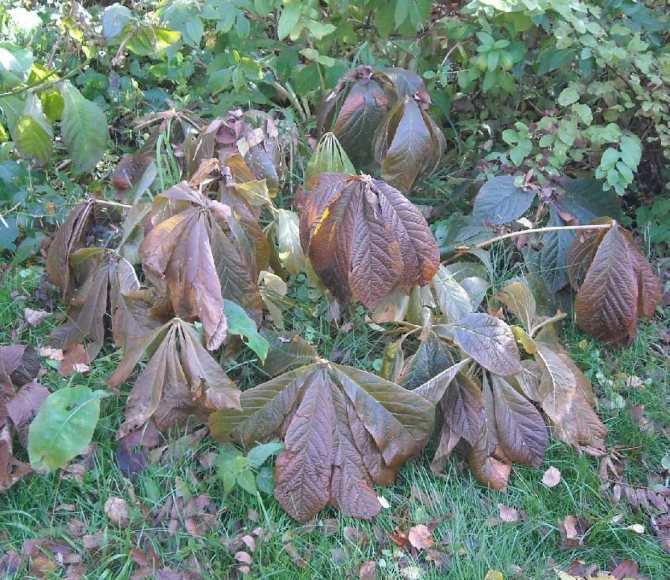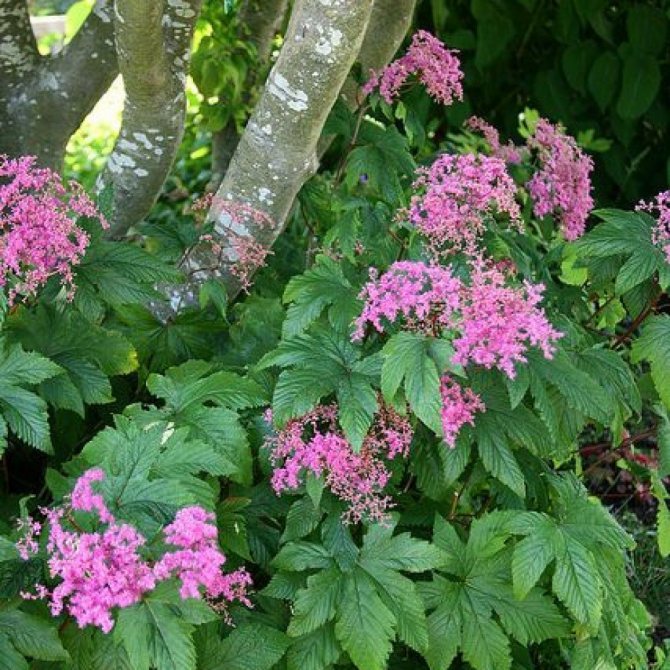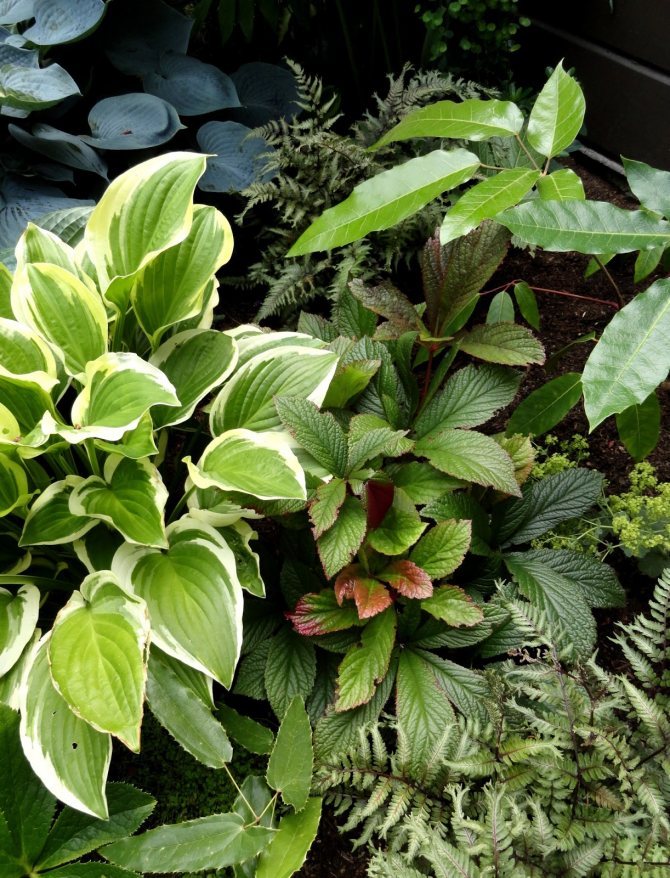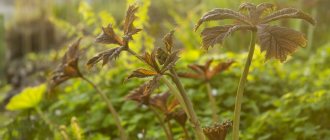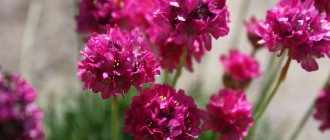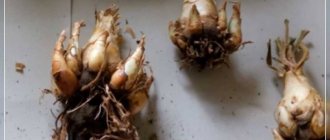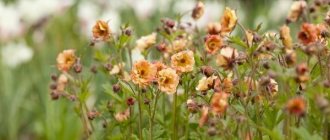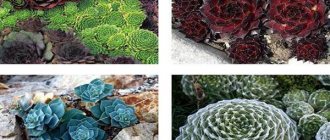Rogersia is an exotic perennial plant that can master a large territory in a couple of years and, with its presence in the garden, create a riot of colors and lush greenery. Experienced landscape designers know very well and for a long time. All beauty is mainly in the leaves, finger-cut with a beautiful relief pattern, the size of which varies from 30 to 80 cm, are able to amaze any gardener with a change of unusual color, from the May bronze-green color they pass in the summer to a matte green hue, and by the fall they completely acquire a brilliant yellow deep color. In this review, we will talk about the features of planting and caring for this perennial in the open field.
Rogersia flower: description
The plant migrated to domestic lands at about the same time, as a result of expeditions to China through the Khingan Mountains, but was not described, so later the name Rogersia stuck unhindered.
Rogersia is a perennial herb belonging to the Saxifrage family, genus Rodgersia.
Despite the origin, the domestic climate is suitable for Rogers: the flower withstands winter and, with proper watering and choosing a place, survives the summer perfectly.
Rogers - general characteristics
Rogersia is a herbaceous perennial with a tap root system, which is especially developed in young plants, and in adults, the rhizome is a modified stem, with adventitious roots extending from it. Thick rhizomes are located just below the soil surface, covering quite large areas. The plant prefers partial shade and rich moist soil, but is afraid of bright sunlight and wind.
Rogersia is famous for its leaves: large, beautiful, highly textured, with a bronze, copper, brown or metallic tint.
The leaves are located on strong stems and, depending on the species, are with varying degrees of dissection of the leaf blade.
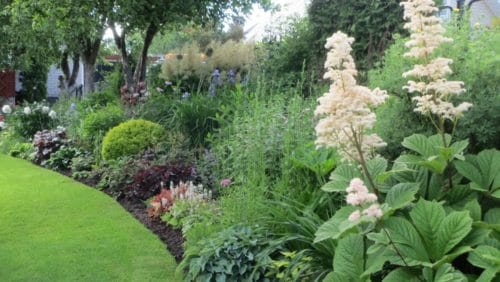
Rogersia looks very good in a large rockery or rocky garden
Rogersia blooms in the middle of summer, for a month and a half, after which active leaf growth begins. Flowers - very small and fragrant, collected in a large inflorescence-panicle. Their colors range from white, yellow to pink and red. The plant is pollinated exclusively by insects and is a good honey plant.
Rogersia belongs to the saxifrage family, in which its genus is one of the smallest - currently there are only 5 recognized species and dozens of varieties.
The homeland of this plant is shady moist forests in southeast Asia, the Honshu Islands in Japan and Korea, and some species are also found in China, Tibet and Nepal. Strong stems grow to a height of about one and a half meters, but this depends on the variety and growing conditions, the dry fruit is a capsule.


In the photo, Rogersia horse chestnut is a special variety, which is distinguished by the largest leaves or mighty petioles and special flowering
Description and photo
Shade-loving Rogers is perfect for corners of the garden, sheltered from the sun by tree crowns or buildings, and planted along the banks of reservoirs. Large dark green lobed leaves on long petioles, like palms stretching upward. By autumn, the foliage becomes reddish or golden.Small flowers are collected in loose paniculate inflorescences of white, cream or pink color.
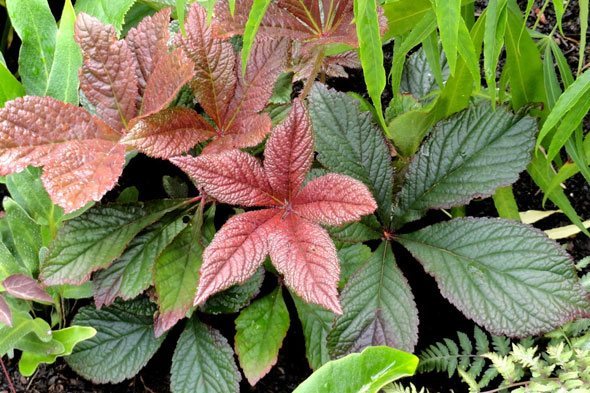

The plant blooms for about 30 days, emitting a pleasant aroma.
Feathery Rogers and Elderberry species
The greatest number of hybrids and various varieties is of the Feathery Rogers, due to this it is more often used to decorate the landscape. Small bushes, up to 60 cm high, are collected from numerous leaf plates, which are located on a long petiole. Visually, the leaves of pinnate rogers are very similar to mountain ash, only much larger and more prominent. At a young age, the leaf plate is orange-brown in color, as in the photo below. Flowers are more often found pink or white with a purple tint, collected in long inflorescences up to 30 cm.In early July, the plant throws out a high peduncle up to 120 cm long. The following varieties are most popular in horticulture:
- 1) Chocolate Wings (Chocolite Wings) is a very decorative plant for any garden. Its peculiarity is that none of the other types of Rogers can compare with large leafy plates of chocolate color, which eventually acquire a dark green tint (usually before flowering). We will see pink flowers in July, they are located on a long peduncle, up to 110 cm long and collected in paniculate fragrant inflorescences
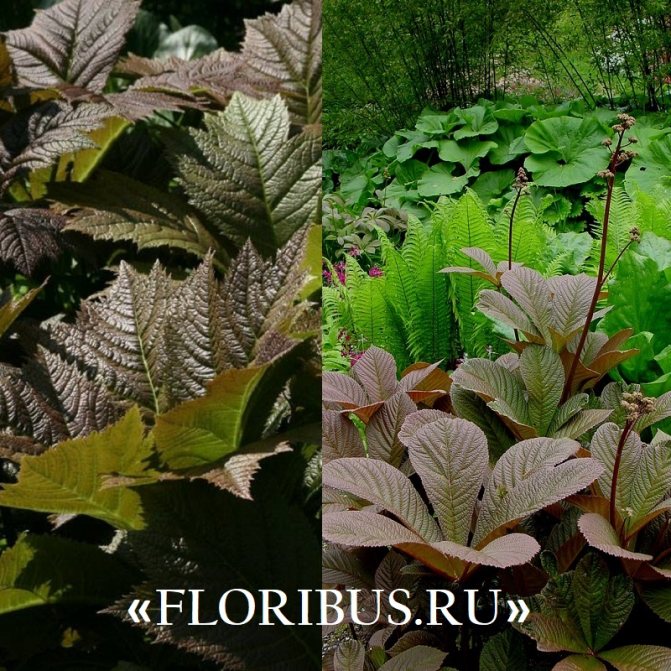

- 2) Elegance is a very elegant garden variety. Its height is no more than 110-120 cm. Leaves are green at any period of life. The flowers are creamy with a pinkish tinge
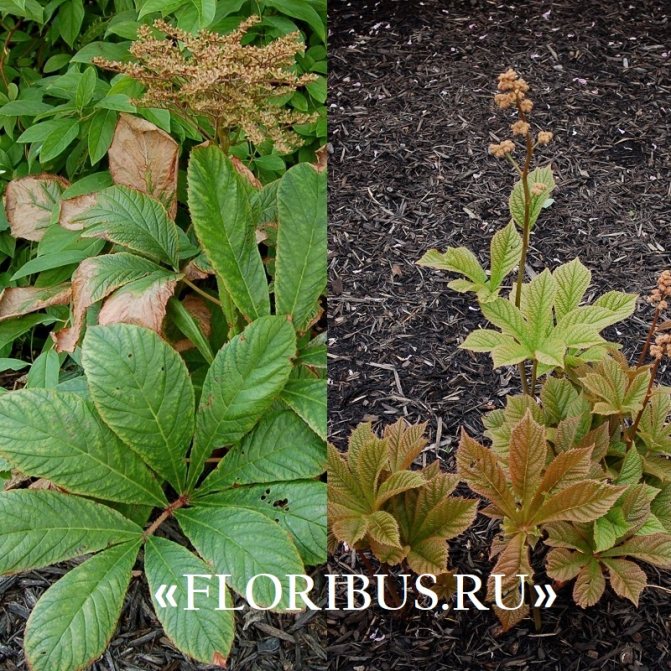

- 3) Dark poker - plants up to 1 meter high with pink small buds. The leaf plates are large, green.


With feathery rogers, the elder-leaved species is often compared. In horticulture, it is used as a more compact plant, up to 120 cm high in flowering (with a bush height of 50-70 cm). If you grow this species in a sunny place, then the leaves will have a bronze tint, in the shade the plates will be painted in a rich green tone.


Reproduction methods
Seed propagation
Not the most convenient way to grow Rogers, because:
- the plant is capable of cross-pollination, therefore, if there are several species on the site, it will be difficult to achieve "purity", and hybrid forms tend to return to the mother;
- the percentage of seed germination is extremely low;
- the flowering period does not occur earlier than 3-4 years.
If, nevertheless, the choice fell on this particular method of reproduction, you must follow the following instructions:
- After flowering, bolls form in place of the inflorescencesin which the seeds are located; the collection of seeds is done after the capsule has dried;
- Seeds are sown immediately after collection in containers... The soil in containers is well moistened and fertilized with organic fertilizers.
- The germination temperature of seeds does not exceed + 5 С, after 2-3 weeks it rises to + 10-15 C.
- When the seedlings reach 10-15 cm, they are transplanted into separate pots.that can be kept outside.
- In autumn, seedlings are planted in open ground, transplanted to a permanent place after two years.
Reproduction by dividing the bush
The most used and easiest way. Advantage: the delenki take the size of an adult plant already in the second year.
To achieve a good result, it is recommended to follow the rules:
- the bush is divided, as a rule, in the fall or at the end of flowering, by cutting off a small extreme part of the root system;
- the seat in size should exceed the size of the rhizome;
- the planted part of the rhizome is deepened by about 6 cm;
- before planting, it is imperative to lay drainage and apply organic fertilizers.
Propagation by cuttings
Rogersia cuttings are formed from both rhizomes (root cuttings) and leaves (leaf cuttings).
When propagated by root cuttings:
- the rhizome of the plant is removed and divided into parts (cuttings) about 10 cm long;
- cuttings are placed in boxes with enriched organic matter and well-moistened soil to a depth of 6-7 cm;
- boxes with cuttings are kept for at least 4 months at a temperature of + 10-15 C;
- after germination, the seedlings are transferred to separate peat pots;
- in mid-late spring, grown Rogers are sent to land in open ground to a permanent place;
- peat, compost or humus are preliminarily introduced into the seat.
When propagated by leaf cuttings:
- the strongest leaf is selected and torn off so that the whole point of growth ("heel") is preserved;
- the stalk is placed in a container with a germination stimulator;
- after the appearance of the roots, the plants are transplanted into pots with a soil mixture for rooting (a substrate with sand is often used);
- the best time for planting in open ground is spring, so that the plant has time to get stronger a year before the arrival of cold weather.
Rogers seedlings: how to grow
If the seeds are purchased in the spring, then you can plant them for seedlings. And how to grow Rogers seedlings is described in detail later in the article.
To do this, we take a moist nutrient substrate (Rogers is not picky about the composition, it is important that it is nutritious and not greasy). We plant the seeds in a flat form at a shallow depth and place the container in a room with zero air temperature (or close to 0). In such a place, you need to keep the seedlings for a week, then increase the temperature of the content to 10-15 degrees. In order for the seedlings to grow strong and hardy, they need to be constantly moistened and fed with nutrient solutions for flowers. We carry out a pick in separate containers only when the young Rogers reaches a height of at least 10-15 cm. We plant the plant in open ground in late spring, closer to summer. It is important to know that seed-grown plants will only achieve "mature" growth at 2 or 3 years of age.
When Rogers is propagated by seeds, great difficulties can arise associated with the germination and long-term appearance of the first shoots. But, it will be much more difficult for those who independently collect planting material, since the perennial is prone to over-pollination. For this reason, if you want to "experiment", then plant different hybrids and varieties far from each other, at a distance.
Preparation for planting in open ground
The choice of planting material
Planting material can be obtained in two ways:
- grow independently from cuttings (seeds);
- purchase a seedling at a specialized point of sale, as well as a nursery.
In any case, uniform criteria are applied to the choice of a seedling:
- the presence of dried out parts or damage is unacceptable;
- special attention is paid to the rhizome: it must be strong, whole and healthy.
When choosing seedlings, they stop at those that have the most developed root system, which will allow the young plant to take root faster in a new place.
Choosing a landing site
When planting a Rogers in a permanent place, first of all, it is taken into account that it is hygrophilous, and direct sunlight can harm, therefore:
- For planting, places in partial shade are recommended (the plant will feel comfortable under the canopy of spreading trees, near the walls of buildings).
- It is good to plant Rogers near a reservoir (in no case should you forget about drainage).
- Landing in areas open to winds and drafts is unacceptable.
Particular care should be taken to prepare the soil, which has the following requirements:
- preferable soil with a slightly acidic or neutral environment;
- Rogersia takes root well on fertile, moderately moist loams;
- the soil should be loose (dug up) and fresh to avoid pest attacks and decay with abundant watering;
- the priority is well-cultivated soil, enriched with nutrients, humus, therefore, pre-fertilization is always necessary.
Watering Rogers
The plant is very demanding for watering. During the hot summer months, Rogers should be watered at least twice a week. Taking into account rains or excessively wet summers, the irrigation schedule can be adjusted. Rogersia is not afraid of watering with cold water, so it can be watered directly with a hose. With the arrival of autumn, but before the first frosts, until work was carried out to shelter the plants for the winter, the main autumn water-charging watering is carried out: at least three buckets of water should fall under each bush. It depends on the abundant autumn application of liquid whether the plant will lay flowering buds or not. The same watering is desirable in the spring, at the beginning of April.
Rogersia: Combination with other plants
Due to the fact that Rogersia is very beautiful and decorative, in combination with other plants, it forms unusual and picturesque plant compositions. A wonderful neighborhood is revealed with bergenia, fern and delicate bells. The plant also looks very impressive in single-species flower beds, comfortably located in a darkened place, for example, under the crown of a tree.
Rogersia in the flowerbed
Tall plants are also suitable as companions: with them they will create a single horizontal surface. The motley mess, which is formed by rogers of various species and other shade-tolerant perennials (this can be red horned goat weed, lungwort, periwinkle), looks beautiful.
Plant transplant
Since Rogers is a perennial plant, it usually does not require replanting for about ten years. But there are situations when it is still necessary. This is a simple procedure that will not take you much time and effort. It is necessary to transplant in late spring, but it is possible even after the cessation of flowering.
First, provide drainage for the soil, dig holes and fertilize them. Remember that the roots should not be outside, so make holes depending on their length. After transplanting, apply mineral fertilizers and water the soil abundantly.
Popular: Purple garden makeover with willow loosestrife
Landing in open ground
Planting in open ground is the most important stage in growing Rogers, since improperly selected conditions or disturbed planting technology can destroy it. To avoid this, you need to know the answers to two questions.
When to plant Rogers?
When propagating Rogers by cuttings or seeds the optimal time for planting seedlings is considered April-Mayso that the plant that has not yet matured is not cold, the frost does not damage it and it has time to get stronger by the winter.
Delenki, planting parts of the rhizome, are planted both in early autumn (subject to winter insulation) and in mid-late spring.
How to plant Rogers in open ground - planting technology
When planting Rogers outdoors, it is recommended to follow these instructions:
- the soil is thoroughly preliminarily cleaned of weeds and dug at least 30 cm deep;
- drainage is laid (small stones, chipped bricks, gravel);
- organic fertilizers are introduced into the hole during planting, as well as deciduous or forest soil;
- the holes in which the seedling is planted should slightly exceed the rhizome in size, which is carefully straightened before planting;
- no need to ground the plant deeper than 6-7 cm;
- after planting, the seedling is watered abundantly, and the soil is mulched with wood ash or peat.
Rogersia takes root well and with proper subsequent care, the seedling will quickly get stronger, and after 2-3 years it will give the first flowers.
Reproduction of Rogers by rhizome
No difficulties will arise during the reproduction of Rogers by rhizome, or rather by dividing it. This is done in spring or autumn, during this period the root is dug up and divided with a sharp knife. We place the strips in pre-prepared small pits to a depth of 5-6 cm.Before planting, it is better to dig up the soil before planting in a few days, or a couple of weeks and add a large amount of humus, peat or compost to it - Rogersia loves organic fertilizers very much, from which it develops and blooms better. In late summer, the plant can be propagated using cuttings: leafy parts with a "heel" are cut.
In order to achieve increased immunity in the fall, the cuttings are placed for germination at home on seedlings. This will require a flat container with a nutrient substrate, which must be moist before the first sprouts. Throughout the winter, the delenki are kept at a temperature of no more than 10-15 degrees, thus creating conditions close to natural for stratification.
Growing from seeds
The method is rarely used due to the fact that it is quite long and is only suitable for patient people.
Seeds do not germinate well, sprouts also develop very slowly.
Sowing begins no earlier than the end of February.
In advance, you need to subject the seeds to processing.
To do this, they are placed in a damp cloth, wrapped in a bag.
After that, they are placed in a refrigerator for 14 days.
Next, they start sowing:
- Containers (pots, boxes, cups) are prepared, the soil mixture is poured into them.
- The seeds are scattered over the surface. You do not need to sprinkle them with earth on top, since they are too small.
- Water with a spray bottle.
- Cover the containers with glass or foil, put them in a warm place.
- With the emergence of seedlings, the film is removed and the containers are transferred to the light.
Important! Drainage or holes must be poured into the bottom of the containers. They are necessary in order to avoid stagnation of moisture in the soil, as this can ruin the plants.
When 2-3 true leaves are formed on the seedlings, you can dive into separate cups.
Care for the seedlings until warm weather is established. Only then can you start transplanting to a new location.
Rogers care
Rogersia is not a demanding and persistent plant, however, do not forget that it has its own little whims, therefore, to ensure proper development, it is better to familiarize yourself with some of the features in care.
Top dressing and fertilization
- Every spring, fertilizing with organic and mineral fertilizers (compost, humus) is carried out.
- In May and July, a solution of complex fertilizers is introduced, which include potassium, phosphorus, nitrogen, zinc, copper and magnesium.
- Fertilizers are applied when planting in the holes and in the process of watering an already planted plant.
- Most of all, Rogers needs feeding and fertilization during the period of active vegetation and flowering.
- Also, in the spring, feeding with a mixture of compost and bone meal is useful.
A plant without timely feeding and fertilization will suffer, so they cannot be neglected throughout the entire growth period.
Watering
The plant is very susceptible to drought, since shady forests are native to him. Therefore, watering should be regular and abundant (it is desirable that the water penetrates at least 20 cm deep into the root soil). Sprinkling is recommended in summer. The most abundant watering time is late spring and summer. Watering is reduced by mid-autumn.
Caution: if the planting site is located near a body of water or other source of standing water, moderate watering and drainage is required.
Loosening and mulching
Rogers needs regular loosening so that the rhizome can breathe and does not attract pests.
To prevent moisture from evaporating quickly, it is recommended to mulch the planting circle. This can be done after disembarkation and after the next loosening. Mulch, as a rule, are peat or tree bark, which can also be a good top dressing.
Diseases and pests
The shrub is resistant to fungal infections. In addition, it has an antibacterial effect that prevents pathogenic diseases and insect attacks.
- Most common pests: slugsthat infect the rhizome, snails, leaves can be affected by rot.
- To prevent diseases, you do not need to abuse watering, make sure that weeds and sod are eliminated in time. In this case, slugs will not settle in the rhizome and root zone, and rot will not start.
- If the plant is already damaged, the diseased parts are removed, and in the daytime, fungicide treatment is carried out.
Preparing for winter
Rogersia is frost-hardy, so it winters well, withstanding frosts down to -25 C, but you should not risk neglecting insulation, especially when it comes to seedlings planted in the first year.
In order for the flower to be well received, it is recommended to follow the following tips:
- You should think about preparing for the winter even when planting the Rogers in a permanent place.: it should be chosen in such a way that the snow melts on it last - this will protect the plant from damage by spring frosts.
- If the rhizome is exposed, it needs to be covered with soil.
- In late autumn, for warming, the rhizome should be covered a layer of woody foliage, spruce branches or humus.
Rogersia pinnate is an exception: a layer of insulating material will need to be denser, since it is less frost-resistant.
A separate stage in preparing a plant for winter is pruning. Peduncles, dried leaves and petioles are removed all summer. But in the fall, the shoots are cut to about the length of the palm.
Transfer
Being a perennial, Rogersia can grow without transplanting in one place for more than 10 years. But if a transplant turned out to be necessary, it is best to do it in mid-late spring. Although transplanting is also permissible in early autumn (after the end of flowering), in this case, special attention is paid to preparing for winter.
Rogersia transplant technology corresponds to the process of planting seedlings in compliance with the following recommendations:
- drainage must be laid;
- organic fertilizers are applied to the hole;
- the rhizome should not show through the topsoil, however, it should not be grounded more than 8-10 cm.
Care secrets
Rogersia is quite unpretentious, so taking care of it is not burdensome even for a novice gardener.
Watering. The plant needs regular watering so that the soil never dries out completely. On dry days, irrigation can be supplemented with spraying.
Weeding. Mulching the soil will help prevent excessive evaporation. It will also keep weeds from growing. If mulching has not been carried out, it is recommended to weed the ground under the thickets once a month.
Fertilizers. On nutritious soils, Rogers does not need regular feeding. It is enough to add compost and a universal complex of mineral fertilizers to the soil in early spring. Additionally, you can make 1-2 dressings during active growth and flowering. Formulations with a high content of copper, potassium, zinc, magnesium, nitrogen and phosphorus are suitable.
Wintering. Rogersia can withstand severe frosts, but needs preparation for the cold season. The leaves, part of the shoots and inflorescences are cut off, and the remaining crown is covered with peat and fallen leaves. In winter, you can cover the bush with snow. If winter is expected to be snowless and frosty, you should additionally cover the plant with non-woven material.
Diseases and pests. Rogersia is a natural antiseptic, so it rarely suffers from diseases. Only dense thickets with waterlogged soil lead to the development of rot. Affected leaves and stems should be cut and destroyed, and the rest of the crown should be treated with a fungicide. Slugs can settle on wet soil, which feed on the succulent growth of Rogers. From them, ash or eggshells can be scattered over the surface of the earth.
Care Tips
Rogersia is a perennial in a shady garden, so choose a shaded area for planting and preferably protected from drafts. The soil prefers fertile and moisture-permeable, without moisture stagnation.
Under natural conditions, culture often grows near water bodies, so it does not like drying out of the soil. You should be especially careful about watering during dry periods - do not skimp on water. Top dressing with organic fertilizers during the growing season will have a good effect on the development of culture and resistance to diseases.
As the flowers wilt, they are cut off, with the exception of the feathery species, since it is especially decorative precisely during the period of seed ripening. Although if the plant is young, then fruiting can weaken it. By winter, it is better to completely cut off the entire green part of the perennial. The culture tolerates frosts quite persistently, but it can suffer from frosts in early spring, therefore, to protect the growth buds, it is advisable to cover the plant with foliage or compost.


Care: watering and feeding
The requirements for watering are increased, since in natural conditions the plant mainly grows in the floodplains of rivers, near water bodies, lover of high humidity and shaded areas... Provide good soil moisture, but no stagnant water, especially regular watering is required in dry weather.
In summer, on hot and hot days, the plant will often need your care to moisten the soil, in other seasons it does not require increased attention.
The soil for planting Rogersia must be loose, fertile, well-drained.
Top dressing is carried out throughout the entire growing season and flowering, preferably alternating organic and mineral fertilizers. In August, you should stop fertilizing, the plant will begin to prepare for wintering.
For the winter period, the plant is sent after trimming the entire above-ground part of the bush and it is advisable to make a shelter from fallen leaves or wood chips.
Why isn't Rogers in bloom?
This question often arises among flower growers who first start Rogers on their site. But don't panic ahead of time! The first flowering period occurs 3-4 years after planting. In the first two years, the plant develops slowly, but then it activates in growth.
The reasons why, after the "adolescent" period, the flower continues to lag behind:
- excess sunlight, dry air, penetration of winds and drafts;
- insufficient winter insulation, leading to freezing;
- lack of watering and feeding;
- parasitizing pests.
If there is no flowering, it is recommended to transplant Rogers to another more suitable place, to pay more attention to the care and diagnosis of diseases.
Features of seed reproduction
Rogers can be propagated by seed, but this method is practically not used for a number of reasons:
- Seeds do not germinate well.
- Seedlings grow very slowly.
- If pollinated by different varieties, the seedling will not receive the varietal characteristics of the mother plant.
- Varietal traits are practically not transmitted, even if the seeds are collected from plants that have been pollinated by the same variety.
This type of plant propagation is useful only for very enthusiastic and patient gardeners for whom varieties do not matter. For others, dividing the bush is best.
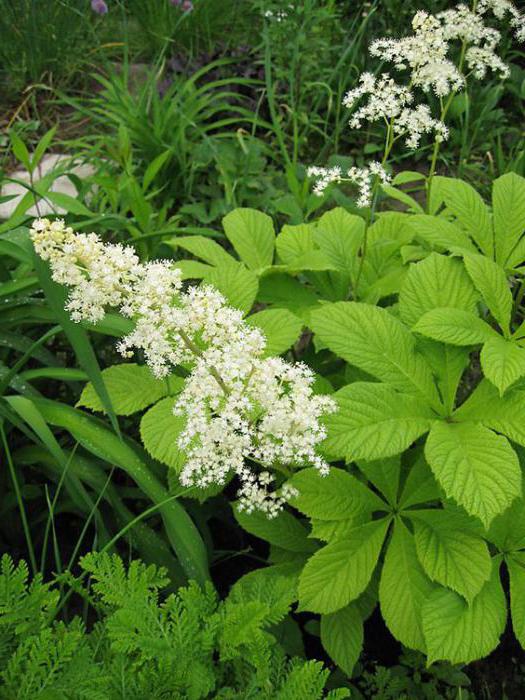

Pest and disease resistance
Rogersia is known for its resistance to many diseases. Pests also very rarely affect it.
The most common disease is rust fungus.
If you examine a plant affected by this ailment, you can see dark spots on the green leaves.
For the prevention and treatment of the disease, leaves and stems are treated with fungicides. It is recommended to remove and burn the affected plant parts.
It is better to process bushes in the morning or in the evening.
It is desirable that the temperature be no more than + 25 ° C.
If rogers grows in wetlands or where water is often stagnant, it can develop root rot.
The plant can die if you do not take action.
You can get rid of the disease by transplanting a flower to another place.
If this is not possible, gardeners recommend digging a bush and placing drainage on the bottom of the hole, planting the flower back. Thus, excess moisture will accumulate in the drainage and will not harm the roots. The most common pests of Rogers are snails and slugs.
They eat the fleshy leaves and stems of the plant.
For the fight, it is recommended to use dry mustard. She needs to sprinkle the bushes early in the morning.
Top dressing of the bush
The first feeding of Rogersia horse chestnut is introduced in the spring. For this, a nitrogen-containing organic fertilizer is used. The bush reacts well to the introduction of nutrients, blooms more abundantly and actively grows foliage. In summer, it is fed at the root with phosphorus-potassium fertilizer. It is important that copper, magnesium, zinc and sulfur are present in complex fertilizers for Rogers. When the plant fades, the inflorescences are removed so as not to spoil the decorative appearance. If desired, it can be transplanted to another place, but, being constantly on one site, it becomes more attractive every year and more and more pleases the eye of its owners.
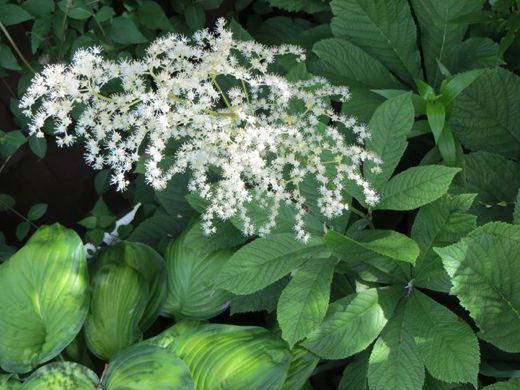

Types and varieties of Rogers
Rogersia horse chestnut (Rodgersia aesculifolia)
It is sometimes called chestnut leaf. This popular type of Rogers has impressive dimensions, reaching a height of one and a half meters. The name is due to the similarity of the leaves with chestnut leaves.
The flowering period lasts a month, coming in early to mid-July, pleasing the eye with massive cream or pale pink paniculate inflorescences. In addition to visual originality, during the flowering period, Rogers chestnut leaves a pleasant, delicate aroma. After flowering, the leaves take on a bronze or purple hue. It has no peculiarities in care.


Rogersia horse chestnut: description of the plant
Rogersia belongs to the saxifrage family. It is decorative and is often used for landscaping European parks, but in Russia it is not yet widespread enough. But it is quite possible that it will soon gain popularity due to its unusual and very decorative appearance. During the flowering period of Rogersia horse-chestnut, the inflorescence of this plant vaguely resembles how the chestnut blooms, but the buds themselves are smaller, white, collected in a panicle.
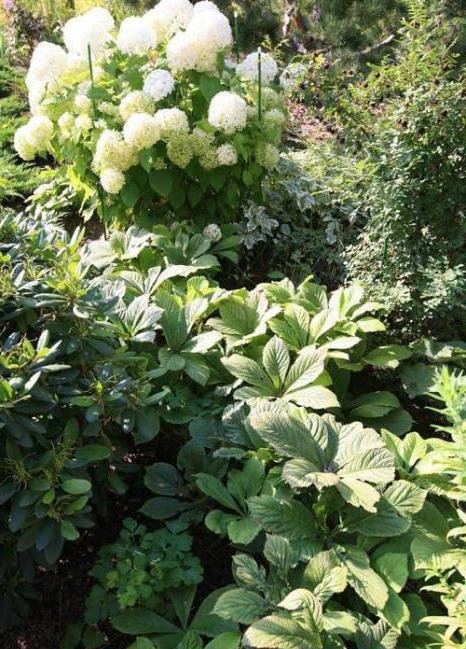

Where to plant?
When choosing a place, you should consider:
- Places open to the sun are not suitable, Rogers grows well in partial shade, protected from cold winds, prefers fertile soil.
- The clumps grow rapidly, occupy an ever larger area every year and can oppress nearby plants. Therefore, Rogers initially need to allocate a larger place.
- Suitable for planting around bodies of water. These moisture-loving plants need regular watering, but with a close occurrence of groundwater, rotting of the root system and death is possible. In this case, a good drainage is required at the selected place.
- Different species, when planted close, can be pollinated, so they need to be placed at a considerable distance from each other.
- In the spring, with late frosts, Rogers may die. If it is not possible to be in the garden twice a day to shelter the sissy in case of possible frost, it is better to plant it in a place where the snow melts last. The plants will grow back later and may be saved.
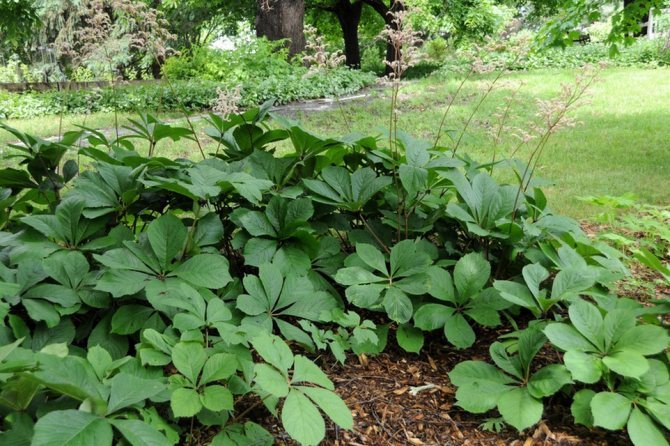

Rogersia horse chestnut (Rodgersia aesculifolia)
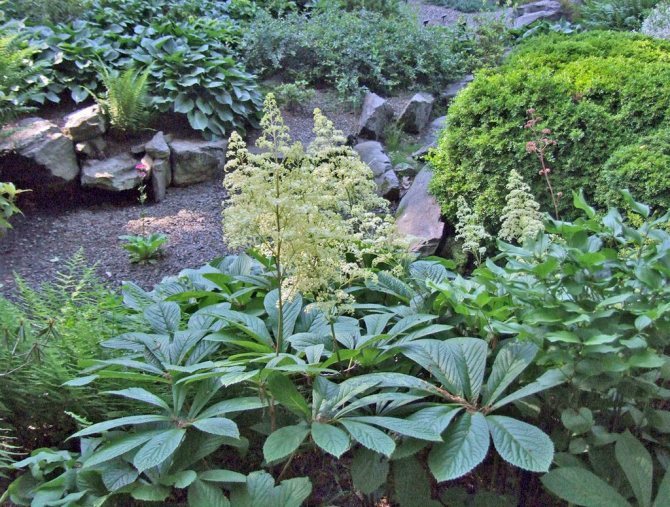

Rogersia elder (R. sambucifolia)


Rogersia feathery 'Fireworks' (Rodgersia Pinnata)
Popular types of flower
There is a lot of debate about the number of species of Rogers - officially recognized and described, at the moment - 5, they differ from each other in the shape of the leaves, color and structure of the leaf. There are several dozen varieties in each species.
Rogersia podophyllum or podophyllum (Rodgersia podophylla)
Leaves consist of 5-7 leaflets with large serrations at the ends. In spring, when they bloom, they have a red-brown color, which gradually becomes more bronze, and in autumn they return to their original color.
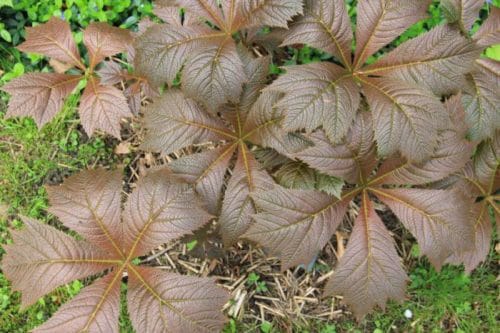

In the photo - rogersia stoolis, in nature it grows in Japan, Korea and China
This is the largest species, reaching a height of 160 cm. The plant has branched inflorescences of white-cream color and sweeping leaves, blooms from mid-June.
Rogersia elder (Rodgersia sambucifolia)
This is one of the most unpretentious and common types. It has massive leaves with a bronze tint that remain green throughout its life. The number of leaves depends on the habitat and on the age of the plant, in some cases, reaches 13. This Rogersia blooms in July - the flowers are tiny, very fragrant, on large and well-branched, their color is white, but quickly aging to brown-green.
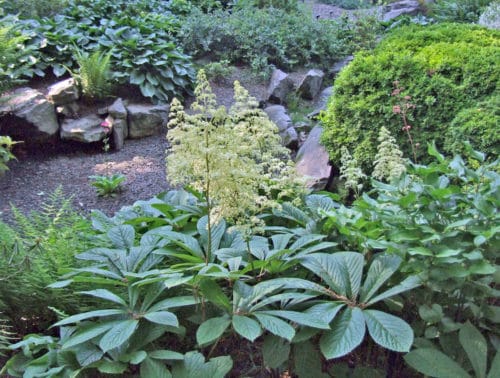

In the photo - Elderberry Rogers, her homeland is the Chinese provinces of Yunnan and Sichuan. The height of an adult plant can only be 60 cm
Rogersia pinnata (Rodgersia pinnata)
It has a very diverse foliage shape, which is why it is often confused with other species. The main distinguishing feature of this species is large leaves with pronounced veins, which are located on the petiole chaotically, like feathers, and turn red-bronze in the fall. The petiole can be very short, then the rogers feathery resembles a palm tree. It blooms in July, the inflorescences are white-pink. This species is the easiest to tolerate a lack of moisture.
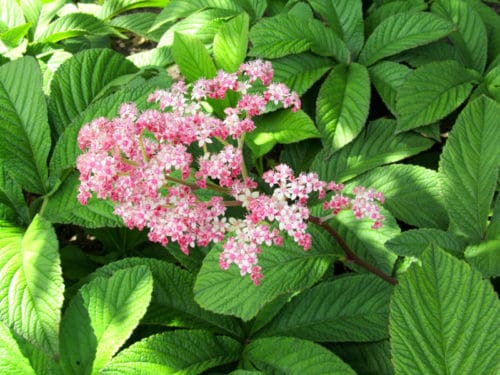

In the photo - one of the most popular varieties of Rogers feathery - Rogersia chocolate wings. It blooms from June to September, and its flowers are similar to a chestnut inflorescence, they are also collected in a large cluster and have a strong aroma.
A small plant up to 70 cm high, has branched inflorescences of white-pink color and low leaves.
Rogersia horse chestnut (Rodgersia aesculifolia)
Its leaves are very similar to those of a horse chestnut, without petioles and are generally greener than other species. The branches of the inflorescences are white, with a pink tinge or even pink, they bloom in June. The height of the plant is about a meter, it tolerates well both shade and sun, but only with the condition of good watering.


Rogersia chestnut-leaved in nature, is found in the mountain pine forests of China, where it grows at an altitude of 2900-3000 m
Rogersia nepalensis
It differs from other species in the shape of the leaf - it has an elongated petiole and noticeably jagged edges. The color of the leaves can fluctuate in blue-green or pale yellow, they are located at a great distance from each other. The inflorescences are lush, pyramidal, of pale green or lemon flowers.
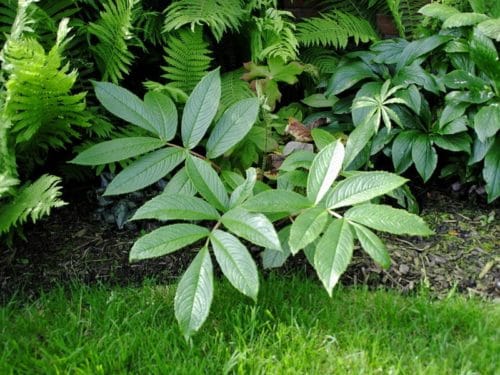

This type of Rogersia is the rarest, but one of the most beautiful, thanks to the unusually shiny foliage.
Rogersia in Landscaping
Due to its impressive size, Rogers is not grown for cut and is practically not used by florists when creating bouquets. Its exclusive advantage is the decoration of the garden, large flower beds, the banks of reservoirs.
The flower will be a great addition to a large rockery, as it develops normally on rocky soil.
Original compositions can be obtained by planting Rogers in the shade of conifers such as thuja, junipers, yews, as well as spreading deciduous trees. Oddly enough, Rogersia will develop normally under willow or pussy willow.
Choosing smaller neighbors, it is best to dwell on other perennials that love moisture and partial shade:
- fern;
- bells;
- decorative rhubarb;
- hosts;
- astilbe.
This elegant giant is often planted against walls and fences, decorating them, and can also serve as a framing of paths.
Using Rogers in landscape design, they take into account that it grows quickly, therefore, they do not allow cramped when planting in compositions.
Rogers diseases and pests
The plant is very unpretentious and practically not damaged by pests and diseases, if it grows in conditions suitable for it. The only thing she can get sick is fungal infections.They arise due to mistakes in care, when the soil is swamped or when watering abundantly, after prolonged drying of the root system. It is very important to water the Rogers properly throughout the growing season. Then she won't get sick. The substrate in which the bush grows also matters. If the soil is airy, loose and rich in nutrients, the bush grows strong, beautiful and has a strong immune system. For the prevention of fungal diseases, it is advisable to periodically spray the crown with a fungicide solution.
Rogersia - trendy perennial
Recently, a plant such as Rodgersia has been used to decorate a garden plot and add originality, zest to its design. She is exotic enough to refresh any corner, and her whimsy remains within reasonable limits. In addition, it is a perennial plant, which means that every year you do not need to think about filling the flower beds with something else, or replanting this culture. Let's see how Rogers is grown (planting and care, photos of landscape compositions in the garden).
Growing Rogers
When planting and caring for Rogers in the open field is finished, it begins as for an adult plant, you need to take time to regularly water the plant, especially in the summer. The bush will not need any more special care. In the fall, when the growing season is over, the plant is cut at the root. Growing Rogers cones-chestnut-leaved in winter does not require special attention from the gardener. The bush is cold-hardy enough and does not need additional shelter for the winter. It easily tolerates frosts down to -25 ° C. You can mulch the ground around the plant with dry foliage, peat chips or other covering material. But a piece of the stem left after trimming the shoots must be left free.
